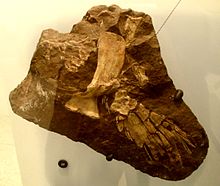Rhizodontida
| Rhizodontida Temporal range: late Middle Devonian (Givetian) - Pennsylvanian |
|
|---|---|
 |
|
| A fossil of Sauripterus taylori | |
| Scientific classification | |
| Kingdom: | Animalia |
| Phylum: | Chordata |
| Class: | Sarcopterygii |
| Clade: | Tetrapodomorpha |
| Order: |
†Rhizodontida Andrews & Westoll, 1970 |
| Families | |
|
|
Rhizodonts (order Rhizodontida) are an extinct group of predatory tetrapodomorph fishes known from many areas of the world from the Givetian through to the Pennsylvanian - the earliest known species is about 377 million years ago (Mya), the latest around 310 Mya. Rhizodonts lived in tropical rivers and freshwater lakes and were the dominant predators of their age. They reached huge sizes - the largest known species, Rhizodus hibberti from Europe and North America, was an estimated 7 m in length, making it the largest freshwater fish known.
The upper jaw had a marginal row of small teeth on the maxilla and premaxilla, medium-sized fangs on the ectopterygoid and dermopalatine bones, and large tusks on the vomers and premaxillae. On the lower jaw were marginal teeth on the dentary, with fangs on the three coronoids and a huge tusk at the symphysial tip of the dentary. Apparently, the left and right mandibles rotated inwards towards each other on biting. This may have been a kinetic mechanism to dig the marginal teeth more deeply into the prey, to help grip slippery or struggling items.
Rhizodonts' trunk was elongated, with pelvic, two dorsal and anal fins much reduced and placed posteriorly The anal and second dorsal fins formed a functional part of the tail. The lateral line system was elaborated on the skull and pectoral girdle - in Strepsodus the main trunk lateral line also had several subsidiary lines running parallel to it. This probably helped rhizodonts detect prey in the turbid, swampy environments where they lived.
Rhizodont pelvic fins are known only from external morphology. They are smaller than the pectoral fins and positioned toward the rear of the body. In comparison to the other fins, the pectoral fins were much enlarged. They had a well-developed internal skeleton surrounded by robust, largely unsegmented lepidotrichia; the whole fin was then covered in deeply overlapping scales. This turned the pectoral fin into a broad paddle.
...
Wikipedia
